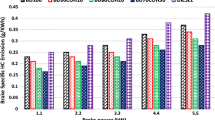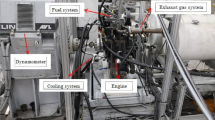Abstract
Renewable fuels have many advantages over fossil fuels because they are biodegradable and sustainable, and help mitigate social and environmental problems. The objective of the present study is to evaluate the performance, combustion, and emission characteristics of a compression–ignition engine using hydrogen compressed natural gas (HCNG)-enriched Kusum seed biodiesel blend (KSOBD20). The flow rate of HCNG was set at 5 L/min, 10 L/min, and 15 L/min, and the injection pressure was varied in the range of 180 bar to 240 bar. Brake thermal efficiency (BTE) and brake-specific fuel consumption (BSFC) were improved when HCNG was added to the KSOBD20. Combustion characteristics, namely, cylinder pressure (CP) and net heat release rate (NHRR), were also improved. Emissions of carbon monoxide (CO), hydrocarbons (HC), and smoke were also reduced, with the exception of nitrogen oxides (NOx). The higher injection pressure (240 bar) had a positive effect on the operating characteristics. At an injection pressure of 240 bar, for KSOB20 + 15 L/min HCNG, the highest BTE and the lowest BSFC were found to be 32.09% and 0.227 kg/kWh, respectively. Also, the CP and NHRR were 69.34 bar and 66.04 J/°. CO, HC, and smoke levels were finally reduced to 0.013%, 47 × 10−6 and 9%, respectively, with NOx levels at 1623 × 10−6. For optimum results in terms of engine characteristics, the fuel combination KSOBD20 + 15 L/min HCNG at FIP 240 bar is recommended.










Similar content being viewed by others
References
Aydin, G.Ö. 2015. The application of trend analysis for coal demand modeling. Energy Sources, Part B: Economics, Planning and Policy 10 (2): 183–191. https://doi.org/10.1080/15567249.2013.813611.
Elkelawy, M., Kabeel, A.E., and Shenawy, E.A. 2020. Experimental investigation on the influences of acetone organic compound additives into the diesel/biodiesel mixture in CI engine. Sustainable Energy Technologies and Assessments 37: 100614. https://doi.org/10.1016/j.seta.2019.100614.
Singh, A., Sinha, S., Choudhary, A.K., et al. 2020. Optimization of performance and emission characteristics of CI engine fueled with Jatropha biodiesel produced using a heterogeneous catalyst (CaO). Fuel 280: 118611. https://doi.org/10.1016/j.fuel.2020.118611.
Elkelawy, M., Alm-Eldin, B.H., Shenawy, E.A., et al. 2021. Study of performance, combustion, and emissions parameters of DI-diesel engine fueled with algae biodiesel/diesel/n-pentane blends. Energy Conversion and Management: X 10: 100058. https://doi.org/10.1016/j.ecmx.2020.100058.
Kamyab, H., Klemeš, J.J., Fan, Y., et al. 2020. Transition to sustainable energy system for smart cities and industries. Energy 207: 118104. https://doi.org/10.1016/j.energy.2020.118104.
Naderipour, A., Abdul-Malek, Z., Arshad, R.N., et al. 2021. Assessment of carbon footprint from transportation, electricity, water, and waste generation: towards utilisation of renewable energy sources. Clean Technologies and Environmental Policy 23 (1): 183–201. https://doi.org/10.1007/s10098-020-02017-4.
Kamyab, H., Yuzir, A., Ashokkumar, V., et al. 2022. Review of the application of gasification and combustion technology and waste-to-energy technologies in sewage sludge treatment. Fuel 316: 123199. https://doi.org/10.1016/j.fuel.2022.123199.
Shah, A., Thipse, S.S., Tyagi, A., et al. 2011. Literature review and simulation of dual fuel diesel-CNG engines. SAE Technical Paper. https://doi.org/10.4271/2011-26-0001.
Deepanraj, B., Lawrence, P., Sivashankar, R., et al. 2016. Analysis of pre-heated crude palm oil, palm oil methyl ester and its blends as fuel in a diesel engine. International Journal of Ambient Energy 37 (5): 495–500. https://doi.org/10.1080/01430750.2015.1004106.
Jaikumar, S., Bhatti, S.K., Srinivas, V., et al. 2022. Combustion, vibration, and noise characteristics of direct injection VCR diesel engine fuelled with Mesuaferrea oil methyl ester blends. International Journal of Ambient Energy 43 (1): 1569–1580. https://doi.org/10.1080/01430750.2020.1713888.
Sina, F.A., Najafi, B., Aghbashlo, M., et al. 2021. Performance and emission analysis of a dual-fuel engine operating on high natural gas substitution rates ignited by aqueous carbon nanoparticles-laden diesel/biodiesel emulsions. Fuel 294: 120246. https://doi.org/10.1016/j.fuel.2021.120246.
Elkelawy, M., Bastawissi, H.A.E., Esmaeil, K.K., et al. 2020. Maximization of biodiesel production from sunflower and soybean oils and prediction of diesel engine performance and emission characteristics through response surface methodology. Fuel 266: 117072. https://doi.org/10.1016/j.fuel.2020.117072.
Elkelawy, M., Din, S.E.H.E., Alm-Eldin, H., et al. 2021. Diesel/ biodiesel /silver thiocyanate nanoparticles/hydrogen peroxide blends as new fuel for enhancement of performance, combustion, and Emission characteristics of a diesel engine. Energy 216: 100614. https://doi.org/10.1016/j.energy.2020.119284.
Sekoai, P.T., Ouma, C.N., Du Preez, S.P., et al. 2019. Application of nanoparticles in biofuels: An overview. Fuel 237: 380–397. https://doi.org/10.1016/j.fuel.2018.10.030.
Jaikumar, S., Srinivas, V., and Meher, R.S. 2021. Combustion characteristics of direct injection diesel engine fueled with dispersant-mixed Al2O3 nanoparticle-added biodiesel blend. International Journal of Thermophysics 42 (6): 1–5. https://doi.org/10.1007/s10765-021-02842-9.
Murugesan, P., Hoang, A.T., Perumal, V.E., et al. 2021. Role of hydrogen in improving performance and emission characteristics of homogeneous charge compression ignition engine fueled with graphite oxide nanoparticle-added microalgae biodiesel/diesel blends. International Journal of Hydrogen Energy 47 (88): 37617–37634. https://doi.org/10.1016/j.ijhydene.2021.08.107.
Koten, H. 2018. Hydrogen effects on the diesel engine performance and emissions. International journal of hydrogen energy 43 (22): 10511–10519. https://doi.org/10.1016/j.ijhydene.2018.04.146.
Chintala, V., and Subramanian, K.A. 2017. A comprehensive review on utilization of hydrogen in a compression ignition engine under dual fuel mode. Renewable and Sustainable Energy Reviews 70: 472–491. https://doi.org/10.1016/j.rser.2016.11.247.
Saravanan, N., and Nagarajan, G. 2008. An experimental investigation of hydrogen-enriched air induction in a diesel engine system. International Journal of Hydrogen Energy 33 (6): 1769–1775. https://doi.org/10.1016/j.ijhydene.2007.12.065.
Hoang, A.T., and Pham, V.V. 2020. A study on a solution to reduce emissions by using hydrogen as an alternative fuel for a diesel engine integrated exhaust gas recirculation; a simulation study on a port-injection SI engine fueled with hydroxy-enriched biogas. AIP Conference Proceedings 2235 (1): 020035. https://doi.org/10.1063/5.0007492.
Bui, V.G., Tran, V.N., Hoang, A.T., et al. 2020. A simulation study on a port-injection SI engine fueled with hydroxy-enriched biogas, energy sources. Energy Sources, Part A: Recovery, Utilization, and Environmental Effects. https://doi.org/10.1080/15567036.2020.1804487.
Bui, V.G., Bui, T.M.T., Hoang, A.T., et al. 2021. Hydrogen-enriched biogas premixed charge combustion and emissions in direct injection and indirect injection diesel dual fueled engines: a comparative study. Journal of Energy Resources Technology 143 (12): 120907. https://doi.org/10.1115/1.4051574.
Bui, V.G., Bui, T.M.T., Tran, V.N., et al. 2022. Flexible syngas-biogas-hydrogen fueling spark-ignition engine behaviors with optimized fuel compositions and control parameters. International Journal of Hydrogen Energy. https://doi.org/10.1016/j.ijhydene.2022.09.133 (Article in press).
Bui, V.G., Bui, T.M.T., Ong, H.C., et al. 2022. Optimizing operation parameters of a spark-ignition engine fueled with biogas-hydrogen blend integrated into biomass-solar hybrid renewable energy system. Energy 252: 124052. https://doi.org/10.1016/j.energy.2022.124052.
Ma, F., Liu, H., Wang, Y., et al. 2008. Combustion and emission characteristics of a port-injection HCNG engine under various ignition timings. International Journal of Hydrogen Energy 33 (2): 816–822. https://doi.org/10.1016/j.ijhydene.2007.09.047.
Mehra, R.K., Duan, H., Juknelevičius, R., et al. 2017. Progress in hydrogen enriched compressed natural gas (HCNG) internal combustion engines-A comprehensive review. Renewable and Sustainable Energy Reviews 80: 1458–1498. https://doi.org/10.1016/j.rser.2017.05.061.
Banapurmath, N.R., Gireesh, N.M., Basavarajappa, Y.H., et al. 2015. Effect of hydrogen addition to CNG in a biodiesel-operated dual-fuel engine. International Journal of Sustainable Engineering 8 (6): 332–340. https://doi.org/10.1080/19397038.2014.963001.
Banapurmath, N.R., Yaliwal, V.S., Hosmath, R.S., et al. 2018. Dual fuel engines fuelled with three gaseous and biodiesel fuel combinations. Biofuels 9 (1): 75–87. https://doi.org/10.1080/17597269.2016.1257316.
Baltacioğlu, M.K., Arat, H.T., and Kenanoğlu, R. 2017. Exergy and performance analysis of a CI engine fuelled with HCNG gaseous fuel enriched biodiesel. International Journal of Exergy 24 (1): 39–56. https://doi.org/10.1504/IJEX.2017.10008170.
Oni, B.A., Sanni, S.E., Ibegbu, A.J., et al. 2021. Experimental optimization of engine performance of a dual-fuel compression-ignition engine operating on hydrogen-compressed natural gas and Moringa biodiesel. Energy Reports 7: 607–619. https://doi.org/10.1016/j.egyr.2021.01.019.
Nanthagopal, K., Subbarao, R., Elango, T., et al. 2011. Hydrogen enriched compressed natural gas (HCNG): A futuristic fuel for internal combustion engines. Thermal Science 15 (4): 1145–1154. https://doi.org/10.2298/TSCI100730044N.
Banapurmath, N.R., Gireesh, N.M., and Tewari, P.G. 2016. Performance, combustion and emission characteristics of a manifold injected HCNG biodiesel dual fuel operation. International Journal of Automotive Engineering and Technologies 4 (4): 201–222. https://doi.org/10.18245/ijaet.88064.
Syed, A., Quadri, S.A., Rao, G.A., et al. 2017. Experimental investigations on DI (direct injection) diesel engine operated on dual fuel mode with hydrogen and mahua oil methyl ester (MOME) as injected fuels and effects of injection opening pressure. Applied Thermal Engineering 114: 118–129. https://doi.org/10.1016/j.applthermaleng.2016.11.152.
Aghbashlo, M., Hosseinzadeh, B.B., Shahbeik, H., et al. 2022. The role of sustainability assessment tools in realizing bioenergy and bioproduct systems. Biofuel Research Journal 9: 697–1706. https://doi.org/10.18331/BRJ2022.9.3.5.
Zahra, S.E., Meisam, R., and Simone, D.S. 2022. The imbalance of food and biofuel markets amid Ukraine-Russia crisis: A systems thinking perspective. Biofuel Research Journal 9: 1640–1647. https://doi.org/10.18331/BRJ2022.9.2.5.
ASTM D976–06. 2016. Standard Test Method for Calculated Cetane Index of Distillate Fuels. West Conshohocken, PA, USA: ASTM International.
ASTM D1298–12b. 2017. Standard Test Method for Density, Relative Density, or API Gravity of Crude Petroleum and Liquid Petroleum Products by Hydrometer Method. West Conshohocken, PA, USA: ASTM International.
ASTM D92–18. 2018. Standard Test Method for Flash and Fire Points by Cleveland Open Cup Tester. West Conshohocken, PA, USA: ASTM International.
ASTM D4809–18. 2018. Standard Test Method for Heat of Combustion of Liquid Hydrocarbon Fuels by Bomb Calorimeter (Precision Method). West Conshohocken, PA, USA: ASTM International.
ASTM D445–19. 2019. Standard Test Method for Kinematic Viscosity of Transparent and Opaque Liquids (and Calculation of Dynamic Viscosity). West Conshohocken, PA, USA: ASTM International.
Sagari, J.K., Sukhvinder Kaur, B., Vadapalli, S., et al. 2020. Comprehensive performance, combustion, emission, and vibration parameters assessment of diesel engine fuelled with a hybrid of Niger seed oil biodiesel and hydrogen: response surface methodology approach. SN Applied Sciences 2 (9): 1–6. https://doi.org/10.1007/s42452-020-03304-x.
Jaikumar, S., Bhatti, S.K., and Srinivas, V. 2019. Experimental explorations of dual fuel CI engine operating with Guizotiaabyssinica methyl ester–diesel blend (B20) and hydrogen at different compression ratios. Arabian Journal for Science and Engineering 44 (12): 10195–10205. https://doi.org/10.1007/s13369-019-04033-z.
Paul, A., Bose, P.K., Panua, R.S., et al. 2013. An experimental investigation of performance-emission trade off of a CI engine fueled by diesel–compressed natural gas (CNG) combination and diesel–ethanol blends with CNG enrichment. Energy 55: 787–802. https://doi.org/10.1016/j.energy.2013.04.002.
Kanth, S., Debbarma, S., and Das, B. 2020. Experimental investigation of rice bran biodiesel with hydrogen enrichment in diesel engine. Energy Sources, Part A: Recovery, Utilization, and Environmental Effects 5: 1–8. https://doi.org/10.1080/15567036.2020.1854391.
Jaikumar, S., Bhatti, S.K., Srinivas, V., et al. 2019. Investigations on performance and emission parameters of direct injection diesel engine running with Mesua ferrea oil methyl ester blends. SN Applied Sciences 1 (11): 1–7. https://doi.org/10.1007/s42452-019-1454-8.
Shariff, S.H., Vadapalli, S., and Sagari, J. 2022. Experimental study on direct injection diesel engine fuelled with ferric chloride nanoparticle dispersed Cassia Fistula biodiesel blend. International Journal of Energy and Environmental Engineering 13 (1): 179–189. https://doi.org/10.1007/s40095-021-00405-0.
Jaikumar, S., Bhatti, S.K., and Srinivas, V. 2019. Experimental investigations on performance, combustion, and emission characteristics of Niger (Guizotiaabyssinica) seed oil methyl ester blends with diesel at different compression ratios. Arabian Journal for Science and Engineering 44 (6): 5263–5273. https://doi.org/10.1007/s13369-018-3538-y.
Jaikumar, S., Srinivas, V., and Rajasekhar, M. 2021. Influence of dispersant added nanoparticle additives with diesel-biodiesel blend on direct injection compression ignition engine: Combustion, engine performance, and exhaust emissions approach. Energy 224: 120197. https://doi.org/10.1016/j.energy.2021.120197.
Saravanan, N., Nagarajan, G., Kalaiselvan, K.M., et al. 2008. An experimental investigation on hydrogen as a dual fuel for diesel engine system with exhaust gas recirculation technique. Renewable Energy 33 (3): 422–427. https://doi.org/10.1016/j.renene.2007.03.015.
Dimitriou, P., and Tsujimura, T. 2017. A review of hydrogen as a compression ignition engine fuel. International Journal of Hydrogen Energy 42 (38): 24470–24486. https://doi.org/10.1016/j.ijhydene.2017.07.232.
Author information
Authors and Affiliations
Corresponding author
Ethics declarations
Conflict of interest
Authors don’t have any conflict of interest.
Additional information
Publisher's Note
Springer Nature remains neutral with regard to jurisdictional claims in published maps and institutional affiliations.
Rights and permissions
Springer Nature or its licensor (e.g. a society or other partner) holds exclusive rights to this article under a publishing agreement with the author(s) or other rightsholder(s); author self-archiving of the accepted manuscript version of this article is solely governed by the terms of such publishing agreement and applicable law.
About this article
Cite this article
Parimi, K.B., Kaur, B.S., Lankapalli, S.V.P. et al. Performance, combustion, and emission characteristics of on a diesel engine fuelled with hydrogen compressed natural gas and Kusum seed biodiesel. Waste Dispos. Sustain. Energy 5, 151–163 (2023). https://doi.org/10.1007/s42768-022-00132-0
Received:
Revised:
Accepted:
Published:
Issue Date:
DOI: https://doi.org/10.1007/s42768-022-00132-0




